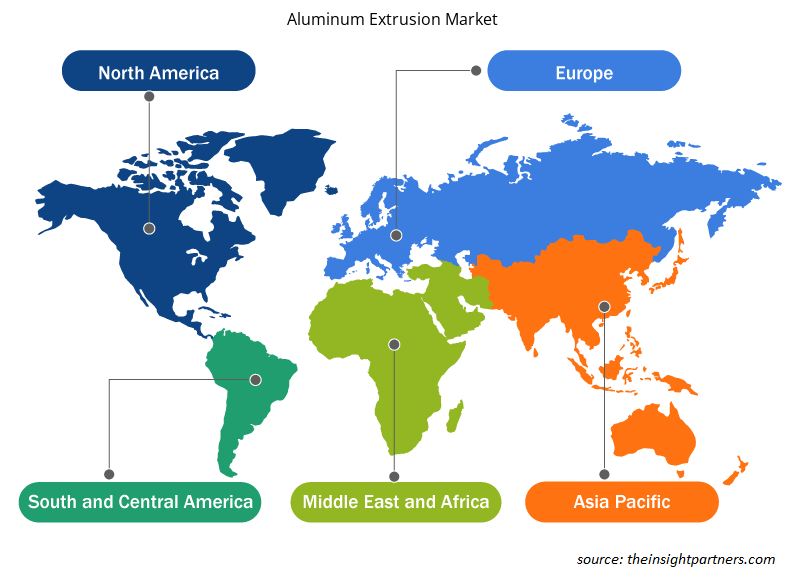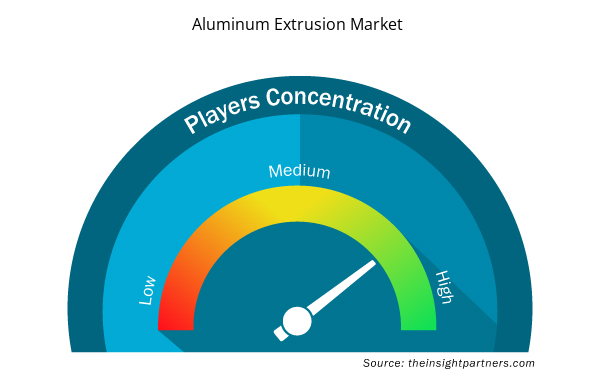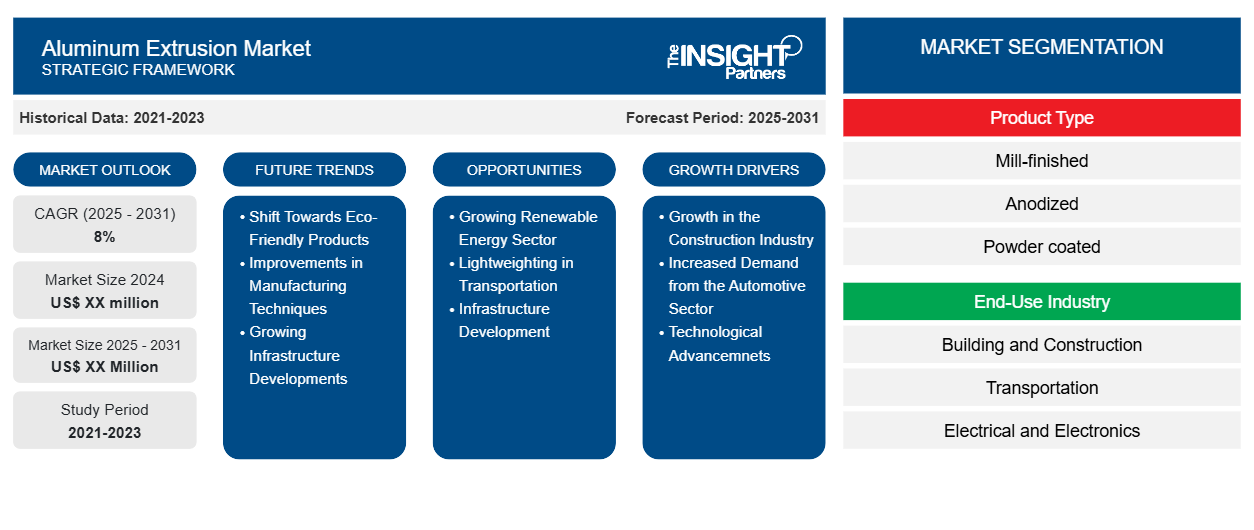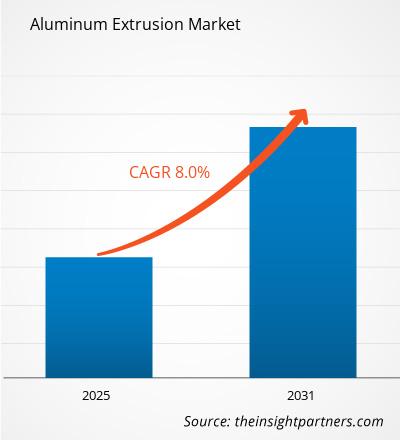Si prevede che il mercato dell'estrusione di alluminio registrerà un CAGR dell'8% dal 2024 al 2031, con una dimensione di mercato in espansione da XX milioni di dollari nel 2024 a XX milioni di dollari entro il 2031.
Il report è segmentato per tipo di prodotto (finito in laminato, anodizzato, verniciato a polvere, altri). Il report presenta inoltre un'analisi basata sul settore di utilizzo finale (edilizia e costruzioni, trasporti, elettricità ed elettronica, beni di consumo durevoli, macchinari e attrezzature, energia solare, altri). L'analisi globale è ulteriormente suddivisa a livello regionale e nei principali paesi. Le dimensioni del mercato e le previsioni a livello globale, regionale e nazionale per tutti i segmenti di mercato chiave sono coperte nell'ambito. Il report offre il valore in USD per l'analisi e i segmenti di cui sopra. Il report fornisce statistiche chiave sullo stato di mercato dei principali attori del mercato e offre tendenze e opportunità di mercato.
Scopo del rapporto
Il report Aluminum Extrusion Market di The Insight Partners mira a descrivere il panorama attuale e la crescita futura, i principali fattori trainanti, le sfide e le opportunità. Ciò fornirà spunti a vari stakeholder aziendali, come:
- Fornitori/produttori di tecnologia: per comprendere le dinamiche di mercato in evoluzione e conoscere le potenziali opportunità di crescita, consentendo loro di prendere decisioni strategiche informate.
- Investitori: condurre un'analisi completa delle tendenze in merito al tasso di crescita del mercato, alle proiezioni finanziarie del mercato e alle opportunità esistenti lungo la catena del valore.
- Enti di regolamentazione: regolamentano le politiche e le attività di controllo sul mercato allo scopo di ridurre al minimo gli abusi, preservare la fiducia degli investitori e sostenere l'integrità e la stabilità del mercato.
Segmentazione del mercato dell'estrusione di alluminio
Tipo di prodotto
- Finito in fabbrica
- Anodizzato
- Verniciato a polvere
Settore di utilizzo finale
- Edilizia e costruzione
- Trasporti
- Elettrico ed elettronico
- Beni di consumo durevoli
- Macchinari e Attrezzature
- Energia solare
Personalizza questo report in base alle tue esigenze
Riceverai la personalizzazione gratuita di qualsiasi report, comprese parti di questo report, o analisi a livello nazionale, pacchetto dati Excel, oltre a usufruire di grandi offerte e sconti per start-up e università
- Scopri le principali tendenze di mercato in questo rapporto.Questo campione GRATUITO includerà analisi di dati che spaziano dalle tendenze di mercato alle stime e alle previsioni.
Fattori trainanti della crescita del mercato dell'estrusione di alluminio
- Crescita nel settore delle costruzioni: la crescente domanda di costruzioni, in particolare di edifici verdi, è un fattore di spinta per il mercato dell'estrusione di alluminio. Le estrusioni di alluminio sono utilizzate nei telai delle finestre, nelle porte e in altri componenti strutturali cedevoli perché sono sufficientemente resistenti e possono essere modellate in diverse forme.
- Domanda crescente dal settore automobilistico: la ricerca di materiali leggeri da parte del settore automobilistico, per migliorare l'efficienza del carburante, spinge il mercato dell'estrusione di alluminio. Ciò ha anche visto l'uso di parti in alluminio estruso nelle strutture dei veicoli, alleggerendo efficacemente senza perdere l'integrità della struttura.
- Progressi tecnologici: i miglioramenti nelle tecnologie di estrusione dell'alluminio, come le modifiche delle formulazioni delle leghe esistenti e i miglioramenti delle tecniche di lavorazione, nonché l'applicazione industriale di queste innovazioni, aumentano positivamente le prestazioni del prodotto e ne ampliano la portata di applicazione, portando alla crescita dei mercati in diversi settori.
Tendenze future del mercato dell'estrusione di alluminio
- Spostamento verso prodotti eco-compatibili: l'inclinazione verso l'edilizia eco-compatibile causerà un'impennata nell'applicazione di estrusioni di alluminio negli edifici. La loro riciclabilità e la maggiore efficienza sono perfette per la costruzione di edifici ecologici, il che è promettente in termini di crescita del mercato negli anni a venire.
- Miglioramenti nelle tecniche di produzione: i progressi nelle tecnologie di estrusione dell'alluminio, tra cui i nuovi design delle leghe e i moderni metodi di lavorazione, si tradurranno in prestazioni migliori e in una più ampia applicazione dei prodotti, con conseguente espansione in vari settori come quello automobilistico e aerospaziale.
- Sviluppi infrastrutturali in crescita: la crescita delle infrastrutture per la produzione di energia rinnovabile, come parchi solari ed eolici, metterà a dura prova il mercato dell'estrusione di alluminio. Inoltre, i sistemi di ventole assiali per turbine presentano opportunità sotto forma di utilizzo di componenti estrusi leggeri che creeranno un'elevata domanda nei prossimi anni.
Opportunità di mercato dell'estrusione di alluminio
- Crescita del settore delle energie rinnovabili: il mercato dell'estrusione di alluminio sta traendo vantaggio dal settore delle energie rinnovabili, in particolare nei telai dei pannelli solari e nei componenti delle turbine eoliche, poiché aumenta la domanda di soluzioni sostenibili.
- Alleggerimento nei trasporti: la spinta verso materiali leggeri nel settore dei trasporti, in particolare ferroviario e aerospaziale, sta ampliando le opportunità per le estrusioni di alluminio grazie alla loro resistenza e versatilità.
- Sviluppo delle infrastrutture: gli attuali progetti infrastrutturali globali stanno incrementando la domanda di estrusi in alluminio nelle applicazioni edilizie, come finestre, porte e componenti strutturali, stimolando la crescita del mercato.
Approfondimenti regionali sul mercato dell'estrusione di alluminio
Le tendenze regionali e i fattori che influenzano il mercato dell'estrusione di alluminio durante il periodo di previsione sono stati ampiamente spiegati dagli analisti di Insight Partners. Questa sezione discute anche i segmenti e la geografia del mercato dell'estrusione di alluminio in Nord America, Europa, Asia Pacifico, Medio Oriente e Africa e America meridionale e centrale.

- Ottieni i dati specifici regionali per il mercato dell'estrusione di alluminio
Ambito del rapporto sul mercato dell'estrusione di alluminio
| Attributo del report | Dettagli |
|---|---|
| Dimensioni del mercato nel 2024 | XX milioni di dollari USA |
| Dimensioni del mercato entro il 2031 | XX milioni di dollari USA |
| CAGR globale (2024 - 2031) | 8% |
| Dati storici | 2021-2023 |
| Periodo di previsione | 2025-2031 |
| Segmenti coperti | Per tipo di prodotto
|
| Regioni e Paesi coperti | America del Nord
|
| Leader di mercato e profili aziendali chiave |
|
Densità degli attori del mercato dell'estrusione di alluminio: comprendere il suo impatto sulle dinamiche aziendali
Il mercato dell'estrusione di alluminio sta crescendo rapidamente, spinto dalla crescente domanda degli utenti finali dovuta a fattori quali l'evoluzione delle preferenze dei consumatori, i progressi tecnologici e una maggiore consapevolezza dei vantaggi del prodotto. Con l'aumento della domanda, le aziende stanno ampliando le loro offerte, innovando per soddisfare le esigenze dei consumatori e capitalizzando sulle tendenze emergenti, il che alimenta ulteriormente la crescita del mercato.
La densità degli operatori di mercato si riferisce alla distribuzione di aziende o società che operano in un particolare mercato o settore. Indica quanti concorrenti (operatori di mercato) sono presenti in un dato spazio di mercato in relazione alle sue dimensioni o al valore di mercato totale.
Le principali aziende che operano nel mercato dell'estrusione di alluminio sono:
- Gruppo Galco
- Banco Alluminio Ltd
- Norsk Hydro Asa
- Arconico
- Constellio
Disclaimer : le aziende elencate sopra non sono classificate secondo un ordine particolare.

- Ottieni una panoramica dei principali attori del mercato dell'estrusione di alluminio
Punti di forza chiave
- Copertura completa: il rapporto copre in modo completo l'analisi di prodotti, servizi, tipologie e utenti finali del mercato dell'estrusione di alluminio, fornendo una panoramica olistica.
- Analisi degli esperti: il rapporto è compilato sulla base della conoscenza approfondita di esperti e analisti del settore.
- Informazioni aggiornate: il rapporto garantisce la pertinenza aziendale grazie alla copertura di informazioni recenti e tendenze nei dati.
- Opzioni di personalizzazione: questo report può essere personalizzato per soddisfare le esigenze specifiche del cliente e adattarsi in modo appropriato alle strategie aziendali.
Il rapporto di ricerca sul mercato dell'estrusione di alluminio può, quindi, aiutare a guidare il percorso di decodifica e comprensione dello scenario del settore e delle prospettive di crescita. Sebbene possano esserci alcune preoccupazioni valide, i vantaggi complessivi di questo rapporto tendono a superare gli svantaggi.
- Analisi storica (2 anni), anno base, previsione (7 anni) con CAGR
- Analisi PEST e SWOT
- Valore/volume delle dimensioni del mercato - Globale, regionale, nazionale
- Industria e panorama competitivo
- Set di dati Excel



Report Coverage
Revenue forecast, Company Analysis, Industry landscape, Growth factors, and Trends

Segment Covered
This text is related
to segments covered.

Regional Scope
North America, Europe, Asia Pacific, Middle East & Africa, South & Central America

Country Scope
This text is related
to country scope.
Domande frequenti
Based on product type, the mill-finished segment is expected to witness the fastest growth during the forecast period
Based on geography, Asia Pacific held the largest share of the aluminum extrusion market due to the well-established manufacturing industry across the region, coupled with continuous growth and development
Rising demand for green building construction is driving the market growth
Hydro Extruded Solutions; Alcoa Corporation; UACJ Corporation; Sapa Group (now part of Hydro); Bonnell Aluminum; Ellwood Group; Extrusions India; Aluminum Shapes, LLC; Aluminum Extruders Council (AEC); Aalco Metal Processing; Northwest Aluminum; Southern Aluminum; Franco Aluminum; Griffon Aerospace; Minalex Corporation
The Aluminum Extrusion Market is estimated to witness a CAGR of 8% from 2023 to 2031
Growth of infrastructure is expected to be the key market trends
Trends and growth analysis reports related to Chemicals and Materials : READ MORE..
The List of Companies
1. Galco Group
2. Banco Aluminium Ltd
3. Norsk Hydro Asa
4. Arconic
5. Constellium
6. Gulf Extrusions
7. Barrak Al-Fares
8. Capital Aluminium Extrusions Limited
9. Hindalco-Novelis
10. Aluminium Products Company
The Insight Partners performs research in 4 major stages: Data Collection & Secondary Research, Primary Research, Data Analysis and Data Triangulation & Final Review.
- Data Collection and Secondary Research:
As a market research and consulting firm operating from a decade, we have published and advised several client across the globe. First step for any study will start with an assessment of currently available data and insights from existing reports. Further, historical and current market information is collected from Investor Presentations, Annual Reports, SEC Filings, etc., and other information related to company’s performance and market positioning are gathered from Paid Databases (Factiva, Hoovers, and Reuters) and various other publications available in public domain.
Several associations trade associates, technical forums, institutes, societies and organization are accessed to gain technical as well as market related insights through their publications such as research papers, blogs and press releases related to the studies are referred to get cues about the market. Further, white papers, journals, magazines, and other news articles published in last 3 years are scrutinized and analyzed to understand the current market trends.
- Primary Research:
The primarily interview analysis comprise of data obtained from industry participants interview and answers to survey questions gathered by in-house primary team.
For primary research, interviews are conducted with industry experts/CEOs/Marketing Managers/VPs/Subject Matter Experts from both demand and supply side to get a 360-degree view of the market. The primary team conducts several interviews based on the complexity of the markets to understand the various market trends and dynamics which makes research more credible and precise.
A typical research interview fulfils the following functions:
- Provides first-hand information on the market size, market trends, growth trends, competitive landscape, and outlook
- Validates and strengthens in-house secondary research findings
- Develops the analysis team’s expertise and market understanding
Primary research involves email interactions and telephone interviews for each market, category, segment, and sub-segment across geographies. The participants who typically take part in such a process include, but are not limited to:
- Industry participants: VPs, business development managers, market intelligence managers and national sales managers
- Outside experts: Valuation experts, research analysts and key opinion leaders specializing in the electronics and semiconductor industry.
Below is the breakup of our primary respondents by company, designation, and region:

Once we receive the confirmation from primary research sources or primary respondents, we finalize the base year market estimation and forecast the data as per the macroeconomic and microeconomic factors assessed during data collection.
- Data Analysis:
Once data is validated through both secondary as well as primary respondents, we finalize the market estimations by hypothesis formulation and factor analysis at regional and country level.
- Macro-Economic Factor Analysis:
We analyse macroeconomic indicators such the gross domestic product (GDP), increase in the demand for goods and services across industries, technological advancement, regional economic growth, governmental policies, the influence of COVID-19, PEST analysis, and other aspects. This analysis aids in setting benchmarks for various nations/regions and approximating market splits. Additionally, the general trend of the aforementioned components aid in determining the market's development possibilities.
- Country Level Data:
Various factors that are especially aligned to the country are taken into account to determine the market size for a certain area and country, including the presence of vendors, such as headquarters and offices, the country's GDP, demand patterns, and industry growth. To comprehend the market dynamics for the nation, a number of growth variables, inhibitors, application areas, and current market trends are researched. The aforementioned elements aid in determining the country's overall market's growth potential.
- Company Profile:
The “Table of Contents” is formulated by listing and analyzing more than 25 - 30 companies operating in the market ecosystem across geographies. However, we profile only 10 companies as a standard practice in our syndicate reports. These 10 companies comprise leading, emerging, and regional players. Nonetheless, our analysis is not restricted to the 10 listed companies, we also analyze other companies present in the market to develop a holistic view and understand the prevailing trends. The “Company Profiles” section in the report covers key facts, business description, products & services, financial information, SWOT analysis, and key developments. The financial information presented is extracted from the annual reports and official documents of the publicly listed companies. Upon collecting the information for the sections of respective companies, we verify them via various primary sources and then compile the data in respective company profiles. The company level information helps us in deriving the base number as well as in forecasting the market size.
- Developing Base Number:
Aggregation of sales statistics (2020-2022) and macro-economic factor, and other secondary and primary research insights are utilized to arrive at base number and related market shares for 2022. The data gaps are identified in this step and relevant market data is analyzed, collected from paid primary interviews or databases. On finalizing the base year market size, forecasts are developed on the basis of macro-economic, industry and market growth factors and company level analysis.
- Data Triangulation and Final Review:
The market findings and base year market size calculations are validated from supply as well as demand side. Demand side validations are based on macro-economic factor analysis and benchmarks for respective regions and countries. In case of supply side validations, revenues of major companies are estimated (in case not available) based on industry benchmark, approximate number of employees, product portfolio, and primary interviews revenues are gathered. Further revenue from target product/service segment is assessed to avoid overshooting of market statistics. In case of heavy deviations between supply and demand side values, all thes steps are repeated to achieve synchronization.
We follow an iterative model, wherein we share our research findings with Subject Matter Experts (SME’s) and Key Opinion Leaders (KOLs) until consensus view of the market is not formulated – this model negates any drastic deviation in the opinions of experts. Only validated and universally acceptable research findings are quoted in our reports.
We have important check points that we use to validate our research findings – which we call – data triangulation, where we validate the information, we generate from secondary sources with primary interviews and then we re-validate with our internal data bases and Subject matter experts. This comprehensive model enables us to deliver high quality, reliable data in shortest possible time.


 Ottieni un campione gratuito per questo repot
Ottieni un campione gratuito per questo repot